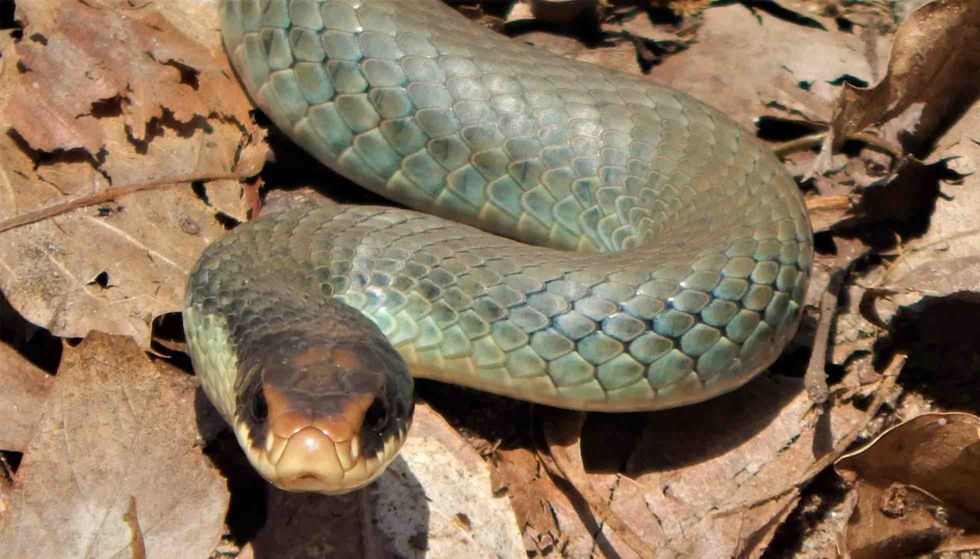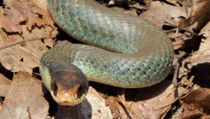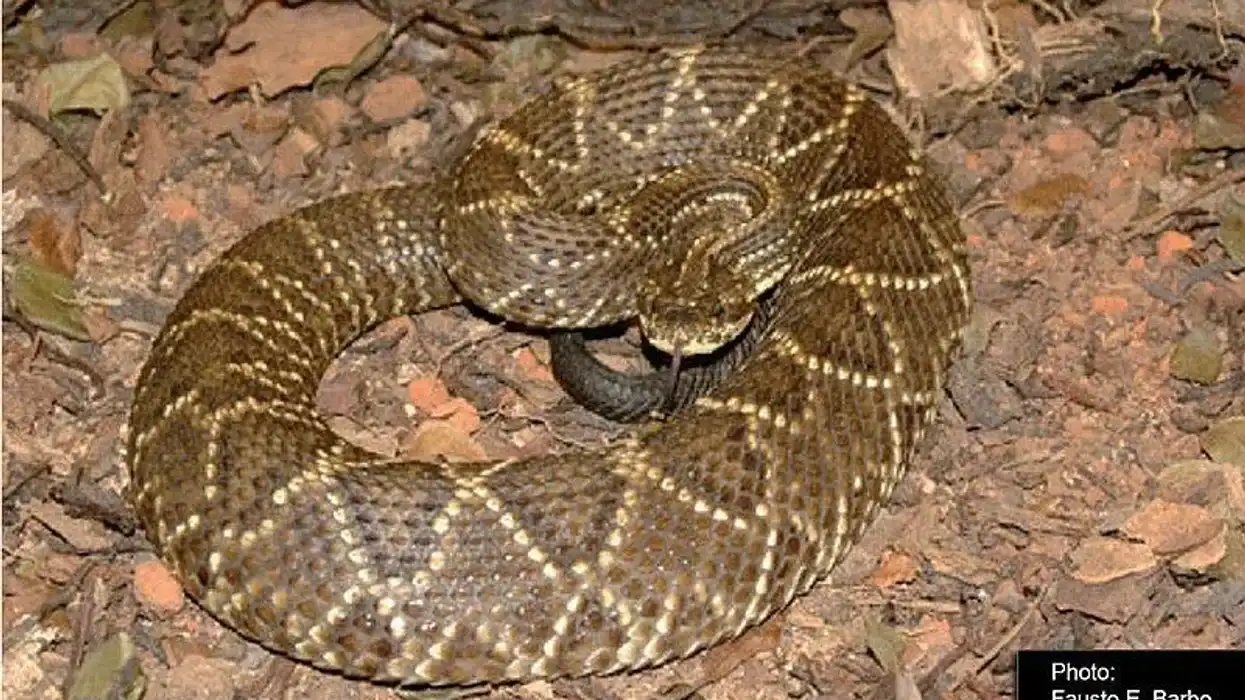The blue racer (Coluber constrictor foxii) is a species of large-sized snake that can be found throughout the United States. It is considered to be the largest snake in Ontario.
This species of snake mainly feeds on rodents, frogs, songbirds, and other species of snakes. A bite from this snake is not life-threatening to human beings, however, they are extremely aggressive by nature.
The habitats of blue racers mainly include open and semi-open regions. Males of this species are known to show aggressive behavior towards one another over territory.
Females lay eggs in protected environments, like under a large rock or decaying log, The eggs hatch in August to September, and the young are 7-11 in ( 20-30cm) in length. This species of snake is a subspecies of the popular species of North American racer.
When they sense an approaching threat, blue racers are known to vibrate their tail, to emit a buzzing sound that will alert other snakes of the approaching danger. They are extremely fast and are known for their speed.
The population of this species has shown a rapid decline gradually. They are currently considered to be an endangered species by several organizations.
If you are fascinated by the blue racer snake, then you may want to read the following amazing facts about them. If you want to learn more about different animals, you can read up on queen snake facts and eastern diamondback rattlesnake facts.
Blue Racer Snake Interesting Facts
What type of animal is a blue racer snake?
The blue racer snake (Coluber constrictor foxii) is a species of snake that can be found in the United States.
What class of animal does a blue racer snake belong to?
The blue racer snake belongs to the Reptilia class of animals. Its scientific name is Coluber constrictor foxii.
How many blue racer snakes are there in the world?
The exact population of this subspecies of snake is not yet known. Their numbers have shown a rapid decline over the ages. They are listed as an Endangered Species by the Committee on the Status of Endangered Wildlife of Canada. Habitat loss is one of the main reasons behind such a huge decline.
Where does a blue racer snake live?
The habitat of the blue racer snakes includes the regions of the United States, Ohio, Washington, South Dakota, Wisconsin, Michigan, and Iowa to name a few.
What is a blue racer snake habitat?
The habitat of the blue racer snake includes open areas or fields where it can easily find and catch its prey. It mostly includes savannah regions or open woodlands.
Who do blue racer snakes live with?
The blue racer snake forms large groups of up to 100 individuals when they hibernate during winter in some places, while in other habitats, the group size is relatively smaller, consisting of only 10-15 individuals.
How long does a blue racer snake live?
The average lifespan of a blue racer snake is 10 years.
How do they reproduce?
April to May is considered to be the breeding season of this species, following which the females lay their eggs under rocks or decaying logs in June. Females are oviparous and can lay eggs twice a year.
The eggs hatch in the months of mid-August to late September. The size of the young ones ranges from 7-11 in ( 20-30cm) in length.
What is their conservation status?
The blue racer snake is Not Listed by the International Union for Conservation of Nature. However, it is marked as an Endangered Species by a few organizations like the Committee on the Status of Endangered Wildlife of Canada.
It has maintained its position in the list of Ontario's Endangered Species since 1971. Habitat loss is one of the main reasons behind its reducing population.
Blue Racer Snake Fun Facts
What do blue racer snakes look like?

We've been unable to source an image of a blue racer snake and have used an image of its habitat. If you can provide us with a royalty-free image of a blue racer snake, we would be happy to credit you. Please contact us at hello@kidadl.com.
The body of an adult blue racer (Coluber constrictor foxii) is covered with bluish-green or pale blue scales. Its belly is white or bluish. It has large eyes and is considered to be the largest snake present in Ontario.
How cute are they?
The blue racer snake may not be cute in particular, but it is extremely beautiful to look at. It's large eyes and unique body color enhance its look further.
How do they communicate?
Like all other species of snake, the non-venomous blue racers communicate with each other through a chemical release known as pheromones. After one snake has released the chemical cues, the other picks it up with the help of its vomeronasal organ and decodes the message it is trying to send.
This vomeronasal organ also helps snakes track their prey or detect any approaching danger.
How big is a blue racer snake?
The blue racer snake is a large snake and the largest snake in Ontario. It is a subspecies of the North American racer snake. The average size of blue racers ranges from 35- 59in (90-152 cm) in length.
How fast can a blue racer snake move?
As the name suggests, this species of snake are extremely fast and can reach speeds of up to 4 mph.
How much does a blue racer snake weigh?
The exact weight of this species of snake is not yet known.
What are the male and female names of the species?
There are no sex-specific names for this species of snake or any other species of snake in general.
What would you call a baby blue racer snake?
A baby blue racer snake is known as a snakelet or a hatchling.
What do they eat?
The typical diet of adult blue racers includes rodents, frogs, other species of snakes, and songbirds. The juvenile blue racer snake typically feeds on insects like crickets. This species of snakes are active foragers, that is they can travel at great distances searching, both on land and in trees, for their prey.
Are they poisonous?
No, blue racers are not all poisonous. They are non-venomous snakes. However, they are aggressive and are not tolerant of human beings. They have many curved teeth, and although their bite won't kill a human, it is sure to inflict pain.
Would they make a good pet?
No, blue racers do not make a good pet at all. They don't do well around human beings and choose a habitat with a low human population. When they feel threatened, they may even chase a human and attack them.
Although they are non-venomous, they have curved teeth which can inflict severe pain on an individual. They are extremely fast runners and are known for their speed. When encountered by a human, they will either run and hide, however, if they feel threatened, they can even attack the person.
Did you know...
Found in Wisconsin, among others, blue racers are diurnal by nature, that is they remain active during the daytime and rest at night.
This species of snake possesses the unique trait of emitting a buzzing sound by vibrating its tail when threatened. This, in turn, warns the other individuals of an approaching threat.
Racer snakes are extremely territorial and will try to defend their territory in all possible ways. They are unlikely to chase a human being though.
Racer snakes do not contain any life-threatening venom for human beings, but their bites can inflict pain on an individual.
Some of the natural predators of the adult blue racers include large-sized birds like the great horned owl, and red-tailed hawk, along with foxes and raccoons. Their eggs or the hatchlings fall prey to a much larger group of predators because of their weak defense mechanisms.
Will a racer snake chase you?
This species of snake is unlikely to chase and attack a human being. They are defensive rather than aggressive by nature and tend to choose a habitat with a low population of human beings. However, if they do bite, although their bites do not contain any venom, they can inflict severe pain.
How can you tell the difference between a black rat snake and a blue racer snake?
The main difference between the black rat snake and the blue racer snake is their body color. The scales of a blue racer snake are bluish-green or pale blue with slightly whiter scales in the belly, however, that of a black rat snake is pitch black.
Rat snakes are good pets and have a calm temperament, as compared to the blue racer snake, which is known to not do well with humans.
The scientific name of the black rat snake is Pantherophis obsoletus. The blue racer snake is a subspecies o the North American racer.
Here at Kidadl, we have carefully created lots of interesting family-friendly animal facts for everyone to discover! Learn more about some other reptiles including Indian cobra facts or grass snake facts.
You can even occupy yourself at home by coloring in one of our free printable blue racer snake coloring pages.










